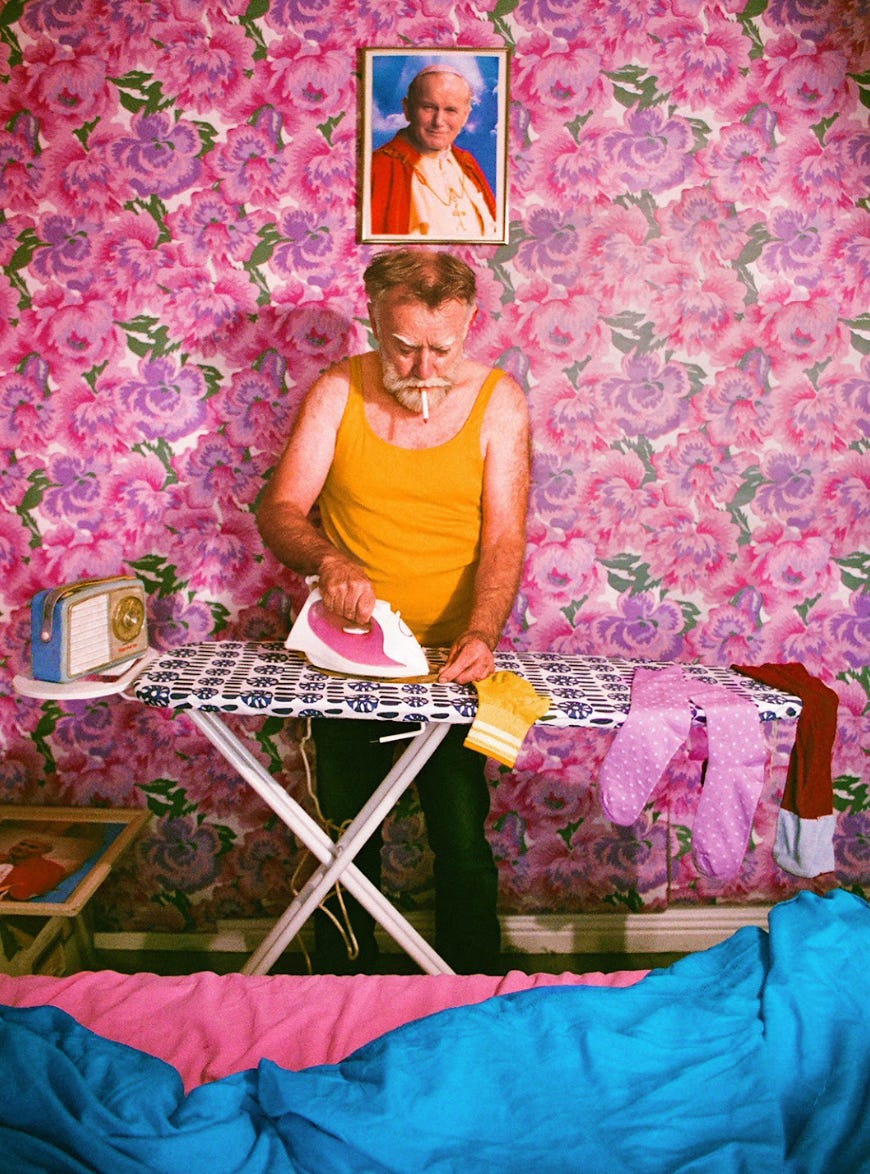This week I went to see In The Press, an exhibition of eleven Irish artists curated by Ciarán Mac Domhnaill and Hazel O’Sullivan. The airy space in Mayfair is provided by Hypha Studios, who connect artists to high-traffic spaces by seeking out landlords with empty units, saving both parties considerable expense.
Between Spicebag’s Through You for a Shortcut (2024) and Ciana Taylor’s Sex Education for Girls (2023), lies the “press” in which the artists and curators have gathered items that remind them of their Irish homes. Both pieces by Spicebag and Taylor are films playing on old fashioned tv sets and laying on top of modest wooden furniture. In this homely layout lies the foundation of the exhibition. Artists have brought items that range from food to towels to prayer books. Curator Ciarán Mac Domhnaill explains: “Hazel and I didn’t want to shy away from politically charged artists, but we did want a theme that was inclusive of both sides of the Irish border. We settled on using the hiberno-English word ‘press’ or cupboard as a bonding mechanism.”
The curators discussed the difficulty connecting with Irish artists in London, especially as some of the older generations are maturing. “This was our opportunity for the young Irish in London to get together and become a temporary collective.” Explains Mac Domhnaill. The artists featured cover a range of topics, including their political, religious, queer, and archival relationship to Ireland, as well as its simple natural beauty.
Venus Patel, Daisy- Prophet of the Apocalypse. 2023. Video. 26 minutes.
One of my favorite aspects of this show was the layering of different video pieces. Overall, the space holds four different films that all look out onto the main exhibition space, except for Chloe Austin’s Archival Discomfort (2024), which remains tucked away in a separate room. The largest screen in the space plays Venus Patel’s Daisy: Prophet of the Apocalypse (2023). This piece’s audio influences each other artwork in the room, like an omnipresent narration that makes itself known as I discover each piece. Patel’s voice is impressive: at times compelling and cajoling us in gentle tones, other times booming over a megaphone to her loyal followers. Her performance is flush with intensity, movement, and colour, easily echoing the tones of artists such as Richard Malone, who is exhibiting Lean, fright, fall (2024), a fantastic fuchsia toned sculpture. As she openly dissects transphobic fears and conservative distrust, she undertakes a radical transformation in mocking undertones, claiming: “Welcome to my church.” Across the room, I hear Patel’s cathedral music play as I sit in a confessional, staring into the delicate mirror hanging two feet away. Ciana Taylor’s Confession Booth (2024) allows me the choice of putting on headphones and listening to a solemn irish priest. I put them on for a moment, joining the devout Catholic prayer, then gingerly remove one ear and listen to Patel’s audio celebrating loudly in the background as each group member is reborn into an uncanny new form.
Enda Burke, Dad’s Socks. 2020. Photography. 71 x 51 cm.
A deep friction seems to exist between staging and capturing, control and chaos in each artwork. In Dad’s Socks (2020), Enda Burke stages a flagrantly vivid and hierarchical scene, where a man can be seen ironing his socks as the pope’s framed picture watches piously over him. If I turn around, however, I am met with a small, glossy, and blurry canvas of what seems to be a naked man in some sort of public setting. I feel frustrated by the lack of context, although Carl Hickey has appropriately named his piece Reverse Pushups in the Nip on Parnell Street (2023), so I suppose that will have to do.
In the back room, away from the hustle and bustle of the other pieces, Chloe Austin’s Archival Discomfort discusses mess. Aware I can still hear Venus Patel yelling faintly, I watch the sterile gloves move across the screen. Austin takes us through a series of quotes and questions about intimacy, knowledge, archives, prerogative and more. She wonders about eroticism and knowledge as she moves her latex gloved-hands across the paper. She asks: who should choose what is put in our institutions? I am reminded of Hazel O’sullivan’s Irish Disc: Unknown (2024) that challenges ownership of and reimagines Irish artefacts currently owned by the British museum.
Hilary Kennedy, Clutching at Straws. 2023. Colour Darkroom Print. 76 x 100 cm.
In this complex system of experiences, there is fresh air. The exhibition maintains a connection to Ireland’s natural landscape through two particular artists. Kelly Ewing explores folklore and myth through her beautiful pieces, such as Lough Bed (2024), using a deep range of colours and markings that remind me of topography and aerial views on a bright sunny day. Pieces like these and the photography of Hilary Kennedy: Clutching at Straws (2023), are a glad respite that provide an in between from each societal qualm the exhibition tackles, and truly captures the essence of Ireland, as well as its evolving culture.
*Images courtesy of Hypha Studios and Ciarán Mac Domhnaill.







